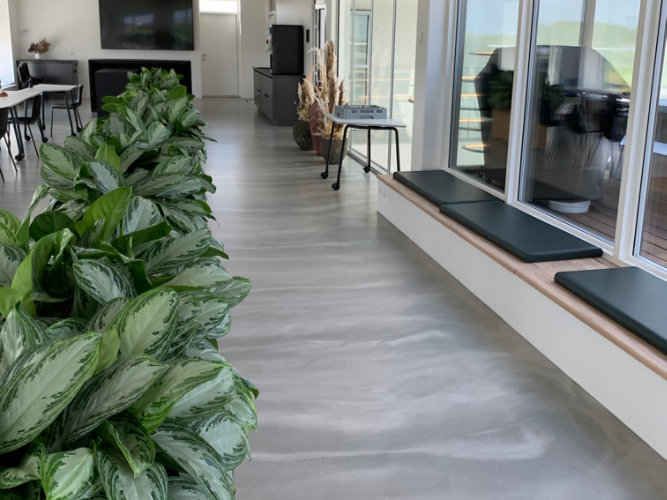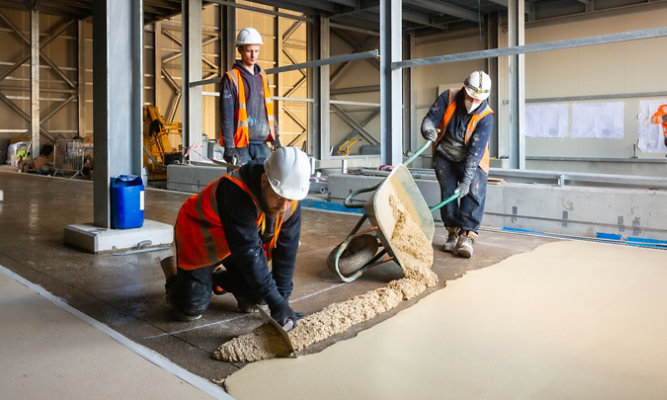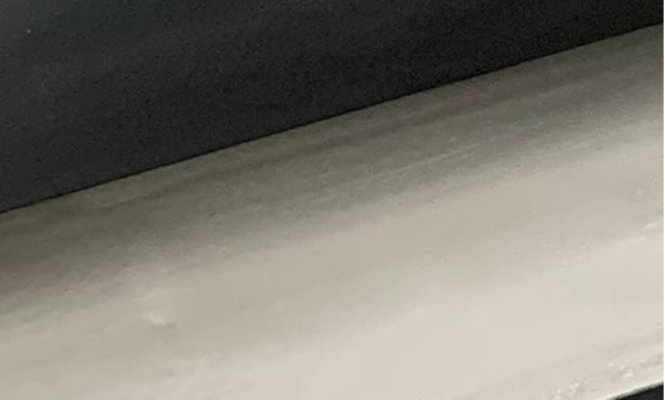Does Your Flooring Finish Need to Contribute to Green Building Points?
At Sherwin-Williams, we know it's vital for specifiers to use flooring materials that contribute to the Green aspects of new building designs with solutions that address sustainability. This can help reduce an environmental footprint.

Most high performance protective floor coatings are traditionally formulated using raw materials which are petroleum or oil-based, meaning that they are very limited in terms of being considered sustainable products. However, the latest resin flooring systems are increasingly designed to deliver outstanding performance and utilise more natural raw materials, such as vegetable oils.
As a result, resin flooring systems can contribute toward achieving Green building status on new and refurbished projects. For this reason, modern innovation for Green credentials establishes an overall statement of how a building project controls and reduces its impact on the environment and aims at achieving a balance with natural resources.
At Sherwin-Williams, we know it's vital for specifiers to use flooring materials that contribute to the Green aspects of new building designs with solutions that address sustainability and help reduce environmental footprint.
As an industry leader, Sherwin-Williams is committed to progressing protective coatings developments to support the creation of greener buildings. Our product innovations support designers, architects and specifiers in achieving green targets for their facilities
Raising the Floor on Building Energy Efficiency Standards
All building materials are now essential in managing the environmental impact of energy consumption during the building process. Protective coatings and flooring finishes form part of this category which is now subject to analysis for any green credentials.
Regulation authorities worldwide are focusing more than ever on this increasingly for new building developments and building refurbishment projects where renovation work includes upgrading existing floor finishes. The UK government's latest standards now require businesses to meet rigorous new energy efficiency standards to lower energy consumption and bills, helping protect the environment.
With the green building revolution now firmly established, all materials used for new flooring projects, refurbishments and repairs will invariably be scrutinised and evaluated to meet the ever-increasing standards and demands set by designers and specifiers.
Directives proposed in the EU aim to increase the annual rate at which EU buildings will be refurbished to control the level of new construction, contribute to efficient energy performance, and set minimum energy performance standards for buildings across Europe. The implication for flooring means that the industry requires affordable long-term solutions with the most negligible impact on waste creation and maintenance.
Helping Specifiers Make the Right Choice
One of the current forms of documentation to help specifiers identify a product's sustainable aspects is EPD (Environmental Product Declaration). An Environmental Product Declaration communicates the environment impact of a product over its life cycle. It reports the effects into a variety of impact categories which can include Global Warming Potential (GWP), Acidification Potential, Smog Formation Potential. and more.
When developing an EPD, the environmental performance of a product is described from a complete perspective with a life cycle assessment (LCA). The LCA study results and other information is compiled in the EPD reporting format. An approved independent verifier then verifies the EPD before being registered and published on the International EPD System.
One of the key sustainability attributes of our sustainably advantaged range of flooring products is it has lower levels of volatile organic compounds (VOCs). VOCs are emitted from certain solids and liquids, and may have short and long term adverse health and environmental effects. Concentrations of many VOCs can be higher indoors than outdoors.
Industrial chemists at Sherwin-Williams have developed innovative coatings, self-levellers, and screeds for industrial floors with low VOC (<150g/l) or no VOC content. As a result, this can contribute to and maintain good air quality for those working with the products and any operatives working in the same area where installation occurs.
Our EPDs are independently verified by NSF International (a trusted third-party accrediting body) by ISO 21930 and ISO 14025, which can count toward the credits needed to obtain sustainability certifications. The NSF verification creates higher value for LEED (Leadership in Energy and Environmental Design) accreditations and is mandatory for BREEAM (Building Research Establishment Environmental Assessment Method) certifications. In addition, unlike many EPDs, which only cover "cradle to gate," the life cycle assessments (LCA) we use to generate the data are complete "cradle-to-grave" assessments. This provides a more holistic approach representing the entire process, from raw material extraction, application and ongoing maintenance to end-of-life.
Such certification means flooring materials can contribute points to international green building rating assessments such as LEED and BREEAM, ensuring buildings comply with sustainable construction. There are more than 100 sustainability certification systems globally – including the leading LEED and BREEAM programs and others such as DGNB, Green Globes, HQE and Green Star. In general, these certifications are not product-based but focused on the whole life cycle of the building. As a result, individual products can contribute towards the credits needed to obtain these certifications.
Certification standards for actual flooring products include well-established tools such as Indoor Air Comfort Gold, confirming product compliance with low emissions criteria. Consequently, this signifies a brand's focus on quality and contribution to a healthy indoor environment. This is a certification that is available on selected Sherwin-Williams products.
Consider Product Life Cycle Against Key Performance Criteria
When looking at sustainability considerations for flooring materials, it's essential to evaluate the whole life cycle process of a product—starting with the sourcing of raw materials along with the actual manufacturing processes to the delivery and installation requirements of a product and its ultimate potential for waste creation. For example, many resin flooring systems are installed on concrete substrates on the principle that they are permanent generic solutions. However, the adhesion and the strength are of such a high standard that the future removal of the floor would be unlikely. This means no time and energy is spent on future system replacement and assures less wastage being sent to landfills.
The sustainable attributes of a product need to be considered in line with the key performance criteria to meet a customer's needs in terms of strength, chemical resistance, cleanability and anti-slip performance compared to other options available. Information from documents such as EPDs now provides comprehensive guidance so the complete impact and performance of a product can be evaluated.
The aesthetic demands can be considered the same way as the product performance, which is essential for specific projects. For example, many industrial building owners and managers now want to look at decorative flooring options in conjunction with performance to create the most modern standards. As a result, this will contribute to staff welfare, production efficiency, and delivering the right impression to customers and visitors who will see a facility. Therefore, resin flooring systems meet functional and aesthetic demands for certain facilities.
Performance Tested Flooring Solutions with Sustainability in Mind
Resin flooring options now don't just offer 'rock hard' finishes designed as abrasion-resistant harsh wearing surfaces. In contrast to these hard surfaces, flexible systems can be installed that still have extreme durability and robustness yet retain a soft and comfortable finish that is modern and attractive for diverse applications.
Designed primarily with footfall in mind, the finish is so tough it's suitable for industrial, commercial, and domestic facilities, providing sound-absorbing ergonomics, improving the acoustic properties, and reducing noise impact on other building areas. As well as being more comfortable for footfall, these systems absorb hard shocks, which minimise the risk of back issues for people using the floors.
The formulations for the comfort flooring systems use the latest resin technology and are free of solvents. They include natural plant oils, contributing to environmental standards across Europe demanding low VOC content and good air quality. In line with other resin flooring products, these systems are free of joints and seams, which can hide dirt, bacteria and be flexible. For this reason, the products prevent the formation of cracks from vibration and heavy-duty wear. This is one of the areas where the latest resin technology is used to expand seamless flooring solutions in-line with green building requirements.
With more than 150 years of successful corporate responsibility, Sherwin-Williams is committed to supplying materials that reduce environmental impact in areas such as greenhouse gas emissions, electricity consumption, and waste reduction. From a variety of environmentally friendly protective flooring solutions, our broad portfolio of products and services can assure designers, architects and specifiers who need to achieve credits and comply with sustainable programs as they progress with building projects.
Discover More
Industry Expertise and Innovation
See how we help customers find customised solutions for their project and application challenges.
Product Lookup
Find out more about our innovative coatings for a variety of industries.
FIND A SYSTEM



